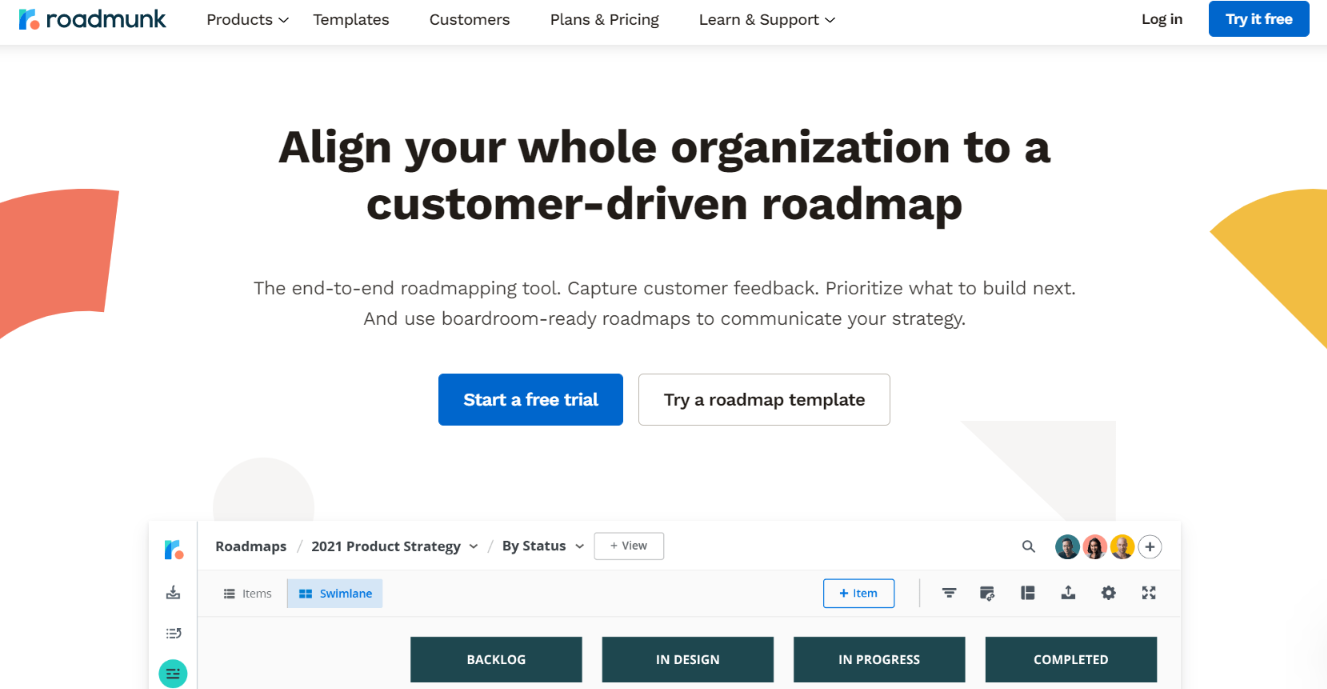
Product tools have exploded in popularity over the last few years as more and more people have been wanting to get into product management. As needs and demands have grown, so have the various platforms to support product managers in their journey.
One of the early tools to hit the market was Roadmunk, led by Canadian founders Latif Nanji, Tomas Benda, and Jalil Asaria. Originally a roadmapping tool, it offered product managers the flexibility they needed to create and share roadmaps with teams and stakeholders.
As we all know, roadmapping is one of the key tasks every product manager has to do.
With so many competitors out there, it’s important to understand the pros and cons of each, and how the tool may help with your overall product process.
In this article we’ll be taking a look at Roadmunk and 8 viable alternatives for you.
TL;DR
All products mentioned in this article have clear strengths and can serve as part of a product management ecosystem. A modern product management tool must cover outcome-focused roadmaps, strong support in product discovery, easy user adoption and seamless scalability for growing teams. According to our evaluation, airfocus is best suited to cover this full set of capabilities a modern product manager needs.
What is Roadmunk, and why look for an alternative?
Roadmunk was founded in 2012 by CEO Latif Nanji, Tomas Benda, Chief Technical Officer, and Jalil Asaria, Chief Revenue Officer, in Toronto, Canada. It started off as a simple roadmapping tool, and over the years expanded into idea and feedback management, becoming a more complete product management tool.
Like all product management tools, it approaches the craft from a unique perspective - often a project one, at that. Regardless of its approach (and whether you agree with it or not) - Roadmunk was acquired by Tempo - a time management software - at an undisclosed amount in 2021.
Falling into buzzwords - why Roadmunk fails to impress
Roadmunk had good intentions. The team tried its best to cater to the wants of the audience - but slipped up when it came to trying to satisfy every need that came their way.
In what can only be described as a buzzword mishap, they describe their tool as a way to “commit to timeline roadmaps” and “create a customer-driven backlog.” Unfortunately, their tool reflects their marketing, even offering a “Scrum roadmap” template.
Showing a somewhat concerning misunderstanding of product management, Roadmunk seems to have fallen into the trap of trying to offer everything to everyone, without thoroughly understanding what or who they’re trying to solve a problem for. After all, would you really want to use a tool that doesn’t understand what it is you’re trying to achieve?
Defining Roadmunk competitors
When it came to looking at Roadmunk competitors, we looked at answering the following:
How does it help with roadmapping and sharing roadmaps?
How does it help with discovery?
How does it help with prioritization?
How does it help with scaling teams?
How does it help with involving other team members?
What is their pricing like?
Why these questions?
Product is hard. As product managers, we do more than build roadmaps - we negotiate, prioritize, communicate, and work with various teams to figure out how to best solve problems for our customers.
This requires a platform that thoroughly understands and supports workflows and processes that will help us reach success - not just one that caters to every SEO keyword whim.
With this in mind, we looked through sources and reviews online to assess our competitor list. As a result, we've chosen the five most recognizable authorities to conduct an investigation:
We used these sources to find the closest Roadmunk Alternatives and compared them with one another.
Here are your top 8 alternatives:
aha!
airfocus
Asana
Jira
Productboard
ProdPad
PPM Express
Let’s get right into it!
1. Aha! Vs Roadmunk
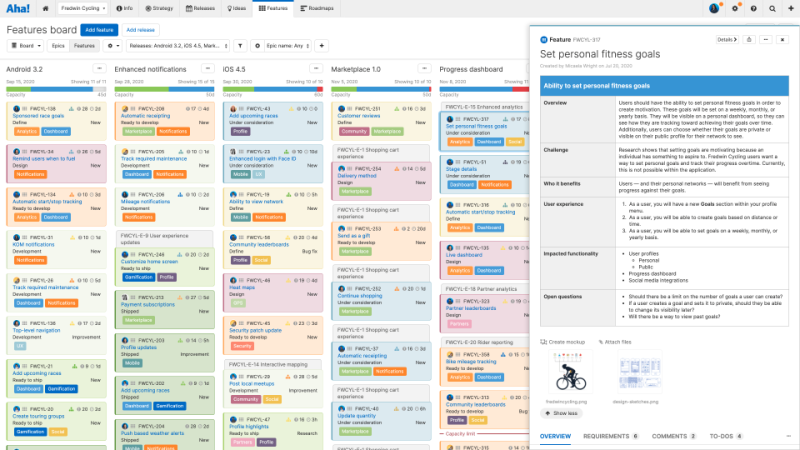
In their own words: “Anything is possible with the world's #1 product development software
Founded in 2013, Aha! was one of the first available product platforms. From the getgo it understood that product managers need more than roadmaps, and expanded its offering to include idea and feedback management. Now focusing on large project-focused enterprises, Aha! offers both product and project management solutions.
Founded in: 2013
Based in: United States
Employees on LinkedIn: 300
Funding: bootstrapped
Website: www.aha.io
How does it help with roadmapping and sharing roadmaps?
Aha! offers extensive roadmap sharing capabilities. It’s important to note though, their approach to roadmapping comes in the form of timelines and Gantt charts. If you’re a product manager wanting to apply better PM practices, such as outcome-based or theme-based roadmaps, you’ll find these options aren’t really within the Aha! realm of possibilities. That said, they do offer the ability to visualize goals and objectives, but all of these are set against a delivery timeline. This puts you in an operational project funnel, not a product one.
How does it help with discovery?
Aha! has a feedback portal where you can engage with your customers so you can gain more insights. Their portal is forum and voting based, which can be difficult with the inevitable Pareto Principle (you’ll have 20% of the loudest people sharing 80% of the feedback.)
Even if you do manage to somehow evade that, creating an internal process is impossible, as all feedback remains on the portal. This makes it difficult to establish an internal feedback management process for your team, using feedback as part of the evidence you’ll need to proceed with a decision and understand problems holistically.
How does it help with prioritization?
Aha! is quite flexible when it comes to applying different prioritization methods, but as a project-focused tool, it ties objectives to timelines and features - not problems and outcomes. It positions itself as being overly reliant on a framework rather than offering you the ability to make a decision based on evidence that sits outside any inputs needed in the algorithm. In other words - if you want the tool to make the decision for you, it might just work.
How does it help with scaling teams?
Aha! is quite flexible and provides custom fields and workflows you can set up for your team. It also offers extensive reporting tools, which will help support cross-functional work as well as reporting upwards.
How does it help with involving other team members?
Aha! comprises a suite of products: Roadmaps, Create, Ideas, Develop and Academy. They are at best clunky at times, and its usability and UI are notoriously confusing and difficult. While the general idea to be able to support cross-functional teams is there, its overly user experience makes it difficult to adopt.
What is their pricing like?
Aha! packages their product in four plans for “Roadmaps” and two for “Ideas”. “Roadmaps” starts at $59 per user per month, paid annually and goes up to $149. “Ideas” is either $39 per user per month, paid annually or $59. You’ll need both products to cover all of your product management activities.
Anything else comes at an added cost.
Pros and Cons
Pros:
Advanced backlog management
Ability to create custom fields
Extensive tracking and reporting
Crowdsourcing and engagement with customers via portal
Cons:
Roadmapping is timeline based
Project-based focus
Complicated UX/UI
Feature management is through voting, not problem solving
Rating
G2: 4.3 out of 5
Capterra: 4.7 out of 5
2. airfocus vs Roadmunk

In their own words: “A platform built for the new way of doing product management”
airfocus is a relatively new tool compared to some of the others on this list, but in its short time it has managed to prove that they understand the difficulties of product in practice, and have designed a tool that adapts to growing and scaling teams. With a unique take on flexibility, modularity, and customization, its approach ensures that the tool adapts to your way of working.
Its offering includes product strategy, discovery, roadmaps and insights management, making it a great complement to any development tool your team is already using.
Founded in: 2017
Based in: Germany
Employees on LinkedIn: 60
Funding: $10M
Website: www.airfocus.com
How does it help with roadmapping and sharing roadmaps?
With airfocus you can create both individual and portfolio roadmaps, all of which are shareable via custom links or through a portal.
To get you started quickly, the platform offers a variety of different templates during onboarding. Templates include roadmaps, but also backlog and feedback management.
All templates and workspaces are 100% customizable, allowing you to define views, fields and user permissions as needed. The flexibility is there to visualize and understand data in different ways, catering to different mind maps.
How does it help with discovery?
airfocus allows you to focus on discovery both from the workflow and insights perspective.
The platform has a heavy focus on customer feedback, even more so with their recently released user portal where you can engage with users directly. As feedback comes in, you can manage that feedback internally through a set of custom workflows, allowing you to link insights from your customers to your backlog and roadmap.
This flexibility means you have full autonomy over how feedback is managed, and keeps your team focused on user needs.
How does it help with prioritization?
airfocus has the most flexible prioritization configurations in any of the available product platforms. Each workspace can be customized to your needs, so regardless of what prioritization framework you want to use, you can easily set it up. There are also prepopulated templates available, making it easier to get going. Each framework comes with an algorithm that will calculate a custom score, which you can then use to visualize how items compare to one another in a handy comparison chart. The chart shows quick wins and strategic items, as well as those that may potentially become time wasters.
The platform also offers a Priority Poker tool, which helps teams align around opportunity priority. With it, a session can be started where team members score opportunities individually, and then discuss what the best way forward might be. It’s certainly a great way of adding inclusivity and teamwork to your process!
How does it help with scaling teams?
airfocus is a modular platform, meaning it is designed specifically to grow and adapt with you. With it, you can design your own set of workspaces - each with its own views, workflows, fields and integrations that support your ways of working.
If there is one thing airfocus understands is that no two teams work the same way. That said, they do provide useful guidance through their templates, tool tips, videos, and various educational content - but you are still free to set up the platform in whichever way is the most helpful to you.
How does it help with involving other team members?
airfocus’ friendly UI ensures that your team will be able to jump on and collaborate with minimal friction. In addition to bringing your team onboard, you can also use forms, portals, and integrations to work with cross-team members, reducing whatever resistance there might be in establishing the platform across your organization.
Their most popular integrations include tools such as Intercom, Jira and Asana, so you can set up a dynamic system across multiple teams.
What is their pricing like?
airfocus offers four pricing plans for their product. Pricing is based on paid seats, while also offering free viewers. The smallest is $19 per user per month, billed annually. The next larger one is $69. The two upper tiers are custom pricing, also billed annually.
Pros and Cons
Pros:
Integrations with development tools like Jira, Trello and AzureDevops
Ability to create and share roadmaps
Portfolio view of multiple roadmaps
Customizable fields and views
Custom prioritization frameworks + priority poker
Customer portal and insights app
Good UI, easy setup
Cons:
Modularity can take bit of time to get used to
Rating
G2: 4.4 out of 5
Capterra: 4.5 out of 5
3. Asana vs Roadmunk
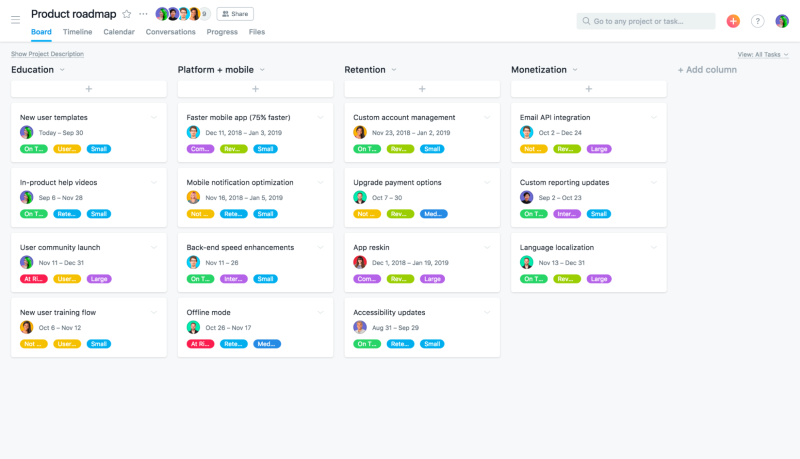
In their own words: “Align teams and drive revenue with a single platform.”
Asana has become one of the most well known development and task management tools in recent years. They’ve expanded their platform to support various teams that require ways of keeping on top of tasks and project deliverables.
Founded in: 2008
Based in: United States
Employees on LinkedIn: 2500
Funding: $453.2M
Website: www.asana.com
How does it help with roadmapping and sharing roadmaps?
As a task-management tool, Asana’s use cases don’t really tackle the needs of product managers beyond the use of timelines. While it is a great tool to help you keep on top of projects, it lacks outcome-based roadmaps, objectives, backlog and feedback management.
That said, it would be a great complement to any other product management tool you are using.
How does it help with discovery?
Asana isn’t really set up to allow you to manage feedback, insights, or research. Its focus is primarily task management, and as such that means you’d struggle to set up a discovery process with it.
How does it help with prioritization?
Asana offers pre-defined labels of high, medium and low - which provides quite a simple way of managing priority. You could create your own custom labels as well, but it’d be difficult to create any sort of framework with an algorithm (given these are all just inputs and fields).
How does it help with scaling teams?
Asana is very well designed when it comes to scalability and team growth - its workspaces, flexibility and customizability make it quite easy to adopt and adapt to growing teams.
How does it help with involving other team members?
The team behind Asana has taken a lot of care when it comes to their UX/UI. It is truly delightful, and you should encounter minimum friction with your team. After all, we all have to manage our projects!
What is their pricing like?
Asana offers three tiers paid per user, billed annually: free, $10,99 and $24,99.
Pros and cons
Pros:
Great UX/UI
Interconnected apps and workflows
Plenty of integrations to choose from
Cons:
It’s a task-management tool, not a product tool
No space for feedback or insights management
No ability to create product roadmaps
Rating
G2: 4.3 out of 5
Capterra: 4.5 out of 5
4. Jira vs. Roadmunk
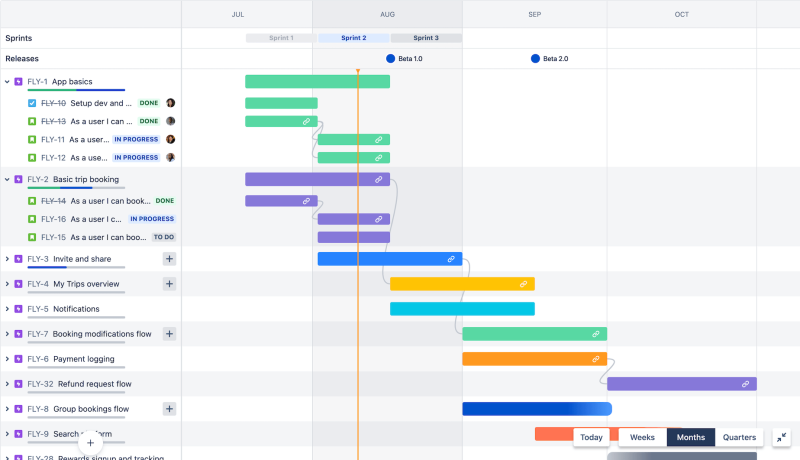
In their own words: “The #1 software development tool used by agile teams
Jira is part of the Atlassian suite of products - a platform built primarily for software development teams. As such, its suite interconnects support, operations, and project teams alike. In addition, they offer over 3000 integrations, putting cross-tool collaboration at the forefront.
Founded in: 2002
Based in: Australia
Employees on LinkedIn: 15.300
Funding: $210M (Secondary market) + $462M(IPO)
Website: www.jira.com
*Data for Atlassian, Jira’s parent company
How does it help with roadmapping and sharing roadmaps?
Unless you purchase either their Premium or Enterprise tiers, you’ll have a difficult time creating external versions of your roadmap with Jira. The added cost may mean a hit to your budget, and if you don’t have it you will have to get creative about how to share your roadmap with team members, board members, and customers.
The platform has made great strides around considering objectives and initiatives, leaning more into product management and better ways of working.
How does it help with discovery?
With the above said, it’s important to consider that a roadmap is never just a stand alone document and requires input from both your product backlog and customer feedback - and that’s where Jira falls short. Because there is no way to keep track of customer feedback with an internal feedback management system, it’ll be hard to really run discovery and research within the tool. You could create a separate board, maybe create links to Confluence documents, but much like other do-it-all tools, this will require your IT manager to approve and set up your integration, causing a bit of a headache (particularly when you need to make changes or adjustments!)
How does it help with prioritization?
Custom fields are necessary to set up prioritization frameworks, and will require knowledge or assistance of someone that has the right permissions to do that for you (like your IT manager.) Again, this causes delays in getting set up quickly, and would be harder to maintain in the long-run.
How does it help with scaling teams?
The whole Atlassian suite was designed to support scalability. With that, however, comes a somewhat complicated administration process. Atlassian has designed so many user permissions, it almost becomes impossible to make any changes to the platform without going through your IT manager, making it a bit difficult to onboard and offboard people in a smooth process.
How does it help with involving other team members?
The vast user permissions can both be a good and bad thing in Jira. It’s great that you can involve other team members and keep things secure, but often assigning those permissions requires an IT manager to set things up correctly. The tool itself has a less than stellar UI (it’s notoriously difficult to navigate), which will cause friction trying to get it adopted by business-facing teams.
A good product team must be able to work closely cross-functionally, and if others refuse to adopt your workspace, teamwork will just be that much harder.
What is their pricing like?
Jira is available at four different prices: free, $7,50, $14,50 per user, per month (no matter if paid annually or monthly). Lastly, an enterprise tier, only available with annual billing from 801 users at $10,70 per user per month.
Pros and cons
Pros:
Dedicated tool for software development teams
Over 3000 apps and integrations available
Customizable boards, reports, timelines, and views
Vast user permissions for security
Cons:
It is not a product management tool
Time-consuming administration process
Confusing layout, configuration, and UI
Rating
G2: 4.2 out of 5
Capterra: 4.4 out of 5
5. Productboard vs Roadmunk
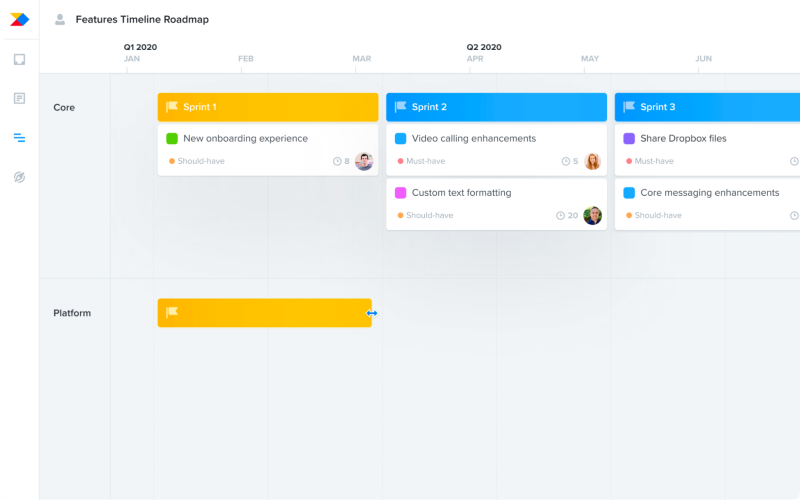
In their own words: “Productboard helps product teams understand what customers need, prioritize what to build next, and align everyone around the roadmap.”
Productboard offers a focus on roadmapping and customer centricity. With offices in San Francisco, Prague, and Vancouver, Productboard has become a global company in recent years.
Founded in: 2014
Based in: San Francisco, California
Employees on LinkedIn: 500
Funding: $125M Series D
Website: www.productboard.com
How does it help with roadmapping and sharing roadmaps?
Productboard’s approach to product management involves working with timeline roadmaps, with templates such as “release roadmap” and “timeline roadmap” readily available. They offer the ability to create a now, next, later roadmap - however it is also focused around releases, not outcomes. They also bypass the concept of initiatives entirely and put features directly on the roadmap, potentially placing you and your team in a build trap.
All of their roadmaps are easily shareable, both through links and through a customized portal.
How does it help with discovery?
Productboard has a user portal that you can use to gather feedback around items in discovery, or just gather general feedback. However, everything in their backlog is a “feature” and the concept of ideas or opportunities are lost - yet another possible red flag when trying to run discovery and experimentation.
How does it help with prioritization?
With Productboard, you are free to set up any prioritization framework of your liking, yet you have no control over how the algorithms are calculated. Because there is a lack of initiatives on the roadmap level, the ability to take other factors into account with the initiative (like objectives, vision, theme) are entirely missed - it all happens on an individual feature level.
How does it help with scaling teams?
Productboard does have the concept of multiple workspaces, but these are not connected to one another. The alternative would be to manage multiple products from a single space - provided your entire team is ok with the same set of views, fields, and workflows. However, if you’d like to provide your various teams with a single source of truth while allowing for more flexibility, Productboard will certainly not scale in that direction.
If you do choose to go through the multiple workspace route, because they are disjointed, you won’t be able to apply any form of cross-team collaboration or be able to roll up multiple roadmaps into a single portfolio for your entire team.
How does it help with involving other team members?
Productboard’s design is certainly “pretty” and delightful to look at - but they’ve slightly missed the mark on real usability. A lot of clicking around is required to figure out where things are, and the UI is, most often than not, incredibly confusing to work with.
What is their pricing like?
Productboard has four different price plans, billed per user per month. Starting at $20, continuing with $80, with the upper two plans available on request.
Pros and cons
Pros:
Focus on customer feedback and insights
Public portal for customer engagement
Ability to share roadmaps
Cons:
Mixed messaging around roadmaps and product approach - is it project or product based?
Price can be quite steep
No focus on discovery, experimentation, or outcomes
Rating
G2: 4.3 out of 5
Capterra: 4.7 out of 5
6. ProdPad vs Roadmunk
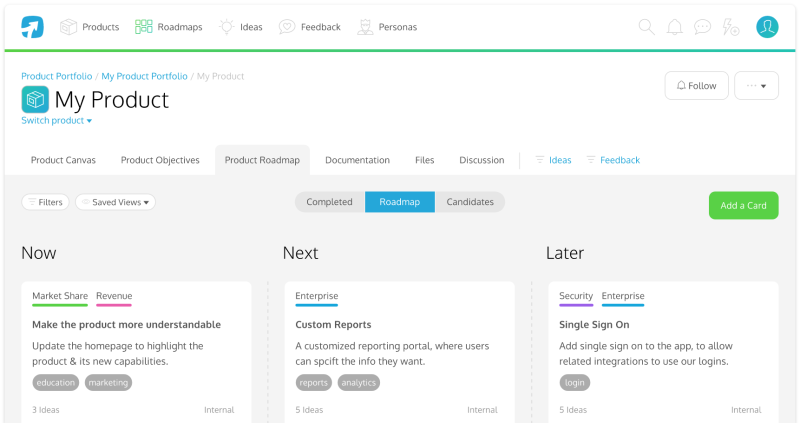
In their own words: “Clear the chaos and unite teams with a single source of truth to create outstanding products.
ProdPad is one of the few outcome-focused tools in the product world. Ensuring you get access to best practices right from the start, this is a great tool for any product team looking to make the switch to an outcome and discovery-focused approach.
Founded in: 2012
Based in: UK
Employees on LinkedIn: 20
Funding: Bootstrapped
Website: www.prodpad.com
How does it help with roadmapping and sharing roadmaps?
The founders behind ProdPad created the original Now, Next, Later roadmap - so if there’s anyone that knows roadmapping best practices, it’s this tool. Their roadmaps are simple yet delightful, with extensive customization around what can be shared. All roadmaps can be shared via a PDF, URL or embed code.
You can also create a portfolio view, so you can gain a holistic view of your product.
That said, it does have certain limitations, like dependency tracking across products.
How does it help with discovery?
ProdPad has a portal and widget that you can use to gather feedback from customers, as well as the ability to set up custom workflows. However, one thing you won’t find in ProdPad is any form of extensive customization for your team. While you can adapt workflows, you cannot set up multiple workflows per team - everyone has to work out of the same workspace and with the same process. Customization on the widget and portal are a bit limited, and are created and shared independently from the roadmap. There are also limitations when creating a custom feedback workflow, as they force you to work with their own approach.
How does it help with prioritization?
ProdPad offers a very basic impact vs effort prioritization scale, which you can visualize as a fibonacci sequence, 1-10 scale, or as t-shirt sizes. Once again, they offer no customization of prioritization frameworks, so you must use the options they offer. If you’re happy with this approach, you won’t have any issues comparing items with one another on their priority chart, which allows you to visualize key strategic items and potential losses.
How does it help with scaling teams?
As we all know, no two teams or organizations work alike. And when you need your entire organization to work from a single source of truth, that’s when things start getting really tricky. ProdPad forces everyone to work out of a single workspace, with no customization over fields, workflows or processes - meaning everyone has to work in the exact same way. Workspaces are available with an Enterprise account, but these are not connected to each other (they’re essentially separate accounts, which you can switch between.)
How does it help with involving other team members?
ProdPad hasn’t done a lot in the way of involving anyone outside the product team. While it is delightful to use, it has no integrations with third-party commercial apps like Intercom or Zendesk, leaving you to rely on tools like Zapier to create integrations. While they do offer a ‘reviewer’ role which you might get your team to take advantage of, all features are available to all roles and permissions at the same time, making it difficult to guide your team towards the right area.
What is their pricing like?
ProdPad’s pricing is based on modules and power-ups.
Their base modules are all $20 per editor/per month for access to roadmaps, ideas and feedback. Their power ups are all $10 per editor per month, and include things like portfolios, OKRs, publishing and portal access.
Pros and cons
Pros
They’re the roadmapping experts
Ability to create a portfolio view
Has access to feedback and portals
Cons
No customization of fields or views
No customization of workflows or processes for backlog or feedback
No customization of priority frameworks
Little in the way of scalability for various teams
Rating
G2: 4.2 / 5
Capterra: 3.8 / 5
7. PPMExpress vs. Roadmunk

In their own words: “Save Hundreds of Hours With integrated Project Portfolio Management Software“.
Like Roadmunk, PPMExpress was also founded in Canada in 2018. Its original strategy was to develop software products and implement PPM on the Microsoft PPM Platform (Microsoft Project, Microsoft Project Server, Microsoft Project Online, Microsoft Project for the Web, and Dynamics 365). After breaking away from being a Microsoft tool only, they’ve expanded their project management software into other areas, including product.
Founded in: 2018
Based in: Canada
Employees on LinkedIn: 17
Funding: bootstrapped + undisclosed initial funding
Website: https://ppm.express/
How does it help with roadmapping and sharing roadmaps?
Having a project-first approach, PPMExpress offers timelines and Gantt charts only. These can be exported to a CSV and as a PNG, however, no external sharing is available via a URL or through a portal.
How does it help with discovery?
PPMExpress offers idea management through an idea dashboard. There you can “propose” ideas and add things like risk and capacity. These ideas can also be linked to strategic objectives.
However, the concept of feedback is entirely missed, meaning you wouldn’t be able to add any sort of customer-focus to your discovery process - or would have to run feedback management from a separate tool.
How does it help with prioritization?
PPMExpress seems to have confused how frameworks are actually meant to be applied. Some of the popular frameworks such as ICE, RICE and WSJF are available - but only on the roadmap level. Individual ideas can also be scored through a “decision matrix” - but with no way for the user to decide what to add/remove as part of that decision matrix.
How does it help with scaling teams?
PPMExpress offers three very basic permission levels on the entirety of product, which can be achieved through regular logins, Microsoft365 or via a Google SSO integration. While getting people invited in seems like a breeze - getting people to use it may be a different story. Because of its focus on project portfolio management, as well as its lack of customer feedback management, it is likely business facing teams will not be using it.
In addition, they do offer several integrations with tools like Jira, Azure Devops and Monday.com
How does it help with involving other team members?
Inviting users is fairly simple, but getting cross-team collaboration will be a challenge, given there’s no integrations with business-facing tools. This will certainly create an issue when trying to keep your entire organization aligned.
What is their pricing like?
PPMExpress offers 3 tiers, Product Management and Portfolio Management each with annual and monthly options starting at $25 per user per month, as well as an Enterprise plan.
Pros and cons
Pros:
Has integrations with Jira and Azure Devops
Deep integration with Microsoft tools
Cons:
Is a project management tool
Difficult UI
No feedback management
All roadmaps are timeline-based
Rating
G2: 4.6 out of 5
Capterra: 4.3 out of 5
8. Trello vs Roadmunk
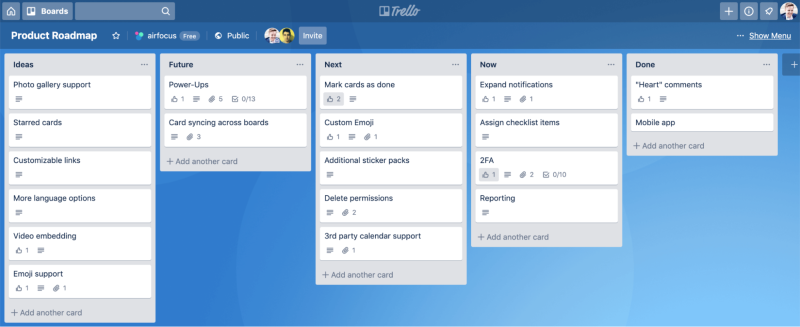
In their words: “Keep everything in the same place—even if your team isn’t.”
Trello is one of the most loved task-management tools out there. (Not so) Recently acquired by Atlassian, they are now part of their ecosystem to expand on task management and software development tools.
Founded in: 2010
Based in: United States
Employees on LinkedIn: 100
Funding: $10M Series A + acquired by Atlassian for $425M
Website: www.trello.com
How does it help with roadmapping and sharing roadmaps?
Trello provides access to boards, each with their own custom fields, labels, and “power ups” (integrations) that you can set up. With that in mind, it’s important to understand that creating boards doesn’t mean that you have a roadmap!
Boards are great for setting up a Kanban workflow - one thing that Trello has absolutely nailed. While you can achieve some semblance of a roadmap with it, it’s not really its main purpose - given that it’s difficult to then create a product hierarchy across multiple boards.
How does it help with discovery?
While you can set up a custom discovery-focused board as well as a separate board for all things dev, you’ll then also need a different board for all of your customer feedback. How many boards can you really work out of without them being thoroughly interconnected?
You can try and make it work, but it simply won’t scale long term.
How does it help with prioritization?
You can make use of Trello’s custom fields and labels to prioritize items, but you will find it difficult to then consider items that live in various other boards. Trello is fantastic and unblocking productivity and making sure you have focus - but that focus is very linear and it becomes difficult to consider various product hierarchy levels (for example: understanding how feedback impacts ideas.)
How does it help with scaling teams?
When it comes to software development and task management - Trello definitely allows you to create workspaces for all your individual and team needs. You can have team boards and private boards, and even share cards in between boards.
How does it help with involving other team members?
Trello is used and loved by people both in and outside product, so you will see minimal friction in adoption.
What is their pricing like?
Prices start at $0, then move up to $5, $10, and $17.50 per user per month, billed annually.
Pros and Cons
Pros:
Really easy to get started
Integrations with hundreds of other tools
High customization
Cons:
It is not a product management tool
Its focus is on task management
Limits on workspaces, boards and commands unless you’re on Enterprise
Rating
G2: 4.4 out of 5
Capterra: 4.5 out of 5
Conclusion
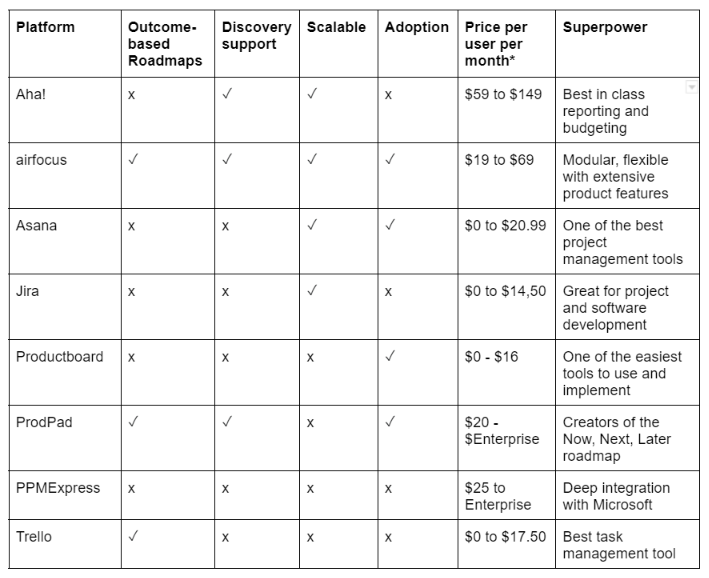
* public prices only, billed annually. All companies offer custom enterprise prices on demand.
Roadmunk started out with good intentions - as all tools do. They’ve unfortunately been slightly misguided in their attempt to expand, and have fallen a bit short when it comes to the needs of product managers around the world.
If you want to learn more about how to apply better product management practices, feel free to check out our academy guide on just that.

Andrea Saez
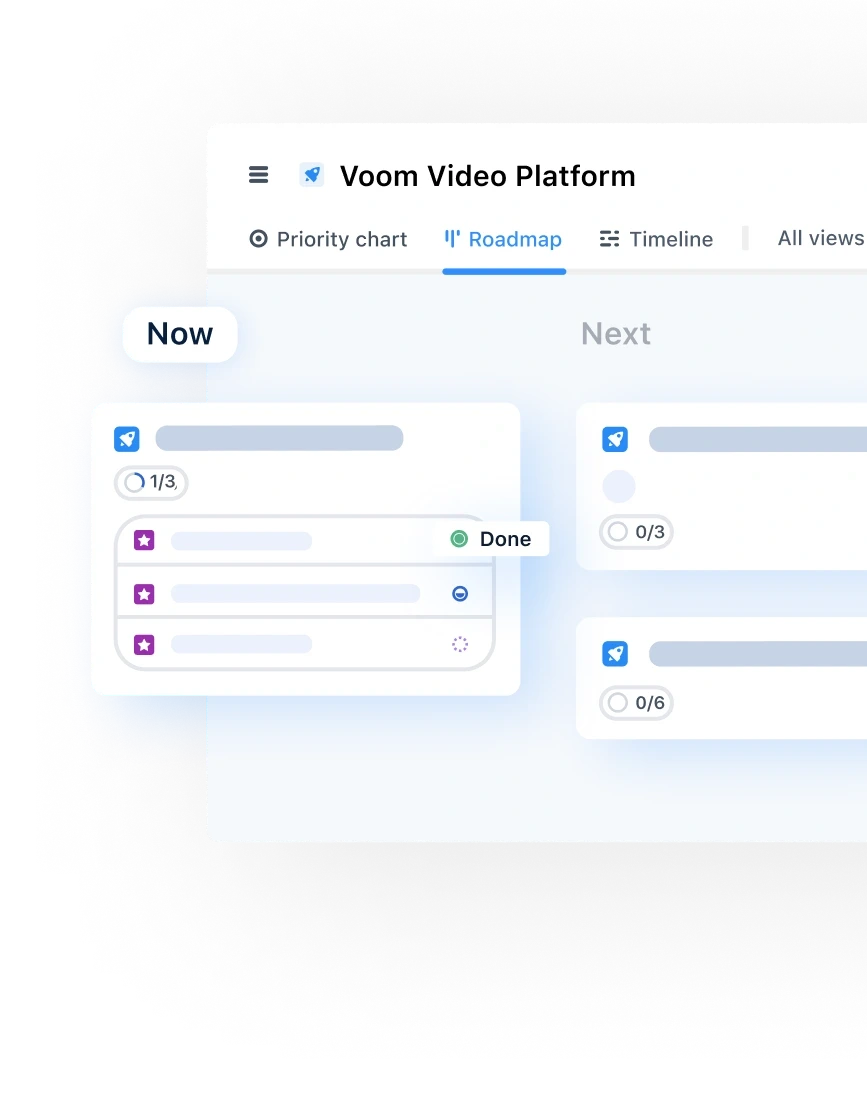
Read also





Experience the new way of doing product management

Experience the new way of doing product management


